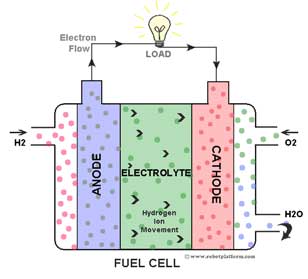Fuel Cells
Fuel Cells are devices which convert chemical energy in fuel to electricity with water and heat as its by-products. Fuel cells continue to produce energy as long as fuel is supplied without requiring any recharge. The most suitable fuel for fuel cell is hydrogen, although other types of hydrocarbon fuels like natural gas, methane etc. are also used.
How fuel cells work?
Typical hydrogen based fuel cells consist of two electrodes sandwiched around an electrolyte where one electrode acts as cathode and another as anode. Hydrogen is fed into the Anode and Oxygen (generally as air) is fed into cathode. The anode catalyst force hydrogen atoms to split into Protons and Electrons. Protons react with oxidants, forcing the electrons to travel through an external circuit towards the cathode generating electricity (DC). At the cathode end, oxygen molecules react with protons and electrons generating Water or Water vapor. If any other hydrocarbon fuel is used, the by-products can be carbon-dioxide and water.
Using hydrogen is clean as there is no burning process leading to polluting by-products; Using a fuel cell is as simple as using a battery and the runtime of a fuel cell is directly related to the amount of hydrogen which can be stored.
Fuel cells in robots
Be ready to hear some good news and some bad news. Good news is that Fuel cells are finally available for robots. Robots powered by fuel cells have already invaded the robotics world. The energy density of a fuel cell is much more than that of a battery and can technically provided infinite power to robots until fuel is fed into it (Yes, in theory). The bad news is that they are not readily available everywhere, and even if available, get very expensive for a poor hobby roboticist.
However, in few years the prices may drop and you will be able to develop your own, inexpensive and efficient fuel-cell powered robot.
Microbial fuel cells
The next big thing in fuel cells is Microbial fuel cells (MFC). Also known as biological fuel cell, the working principle of MFC is same as a generic fuel cell with a cathode and an anode at two ends, but separated by a Proton exchange membrane with Microorganisms as catalysts. Many different kinds of wastes like sewage waste, animal manure can be processed by bacteria releasing energy that can be used to fuel our robots.
How Microbial Fuel Cells work?
To understand MFC, you need to understand how nature works. Bacteria are found everywhere and when they consume wastes, they release electrons along with other by-products. If the released electrons are allowed to flow in a desired way, we have generated electricity.
In a typical MFC, bacteria releases electrons from organic matter (or organic waste) at the anode end. These electrons flow through a load reaching the cathode and later combine with oxygen releasing water. Microbial Fuel cells are already generating waves in the robotic community and there are many robots which take advantage of MFC to power up their circuits. Since bacteria exists everywhere and can survive anywhere, fuel from MFC is effective and an extremely reliable solution. However, the design and usage of a Microbial fuel cell is tedious and the electricity generated in most cases is very minimal. Secondly using expensive catalyst such as platinum has been a big hindrance (although recent advancement shows that other inexpensive catalysts can be used).
If this technology reaches a common man at an inexpensive cost, then we may see many robots using sewage waste to power themselves.
Fuel gas
Using any sort of gaseous fuel like methane, butane, water gas, CNG or LPG requires extreme caution before considering them to power a robot. However there are many professionally made RC helicopters which run on fuel gas. If you are a hobbyist and building your first robot, or built only a few robots, then using fuel gas is not for you.
Fuel gas is greener than petroleum based engines, but at the same time is more complicated and dangerous to design and use. If are a no-risk-taker, go for batteries. In the next section, we will discuss about batteries; one of the most trusted energy sources in robotic community.
Do you have anything to say?
Visit the Forum to discuss, learn and share anything related to robotics and electronics !!









